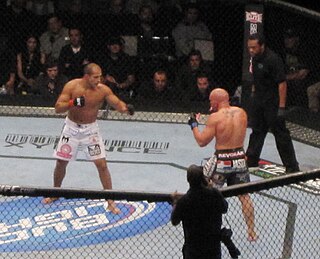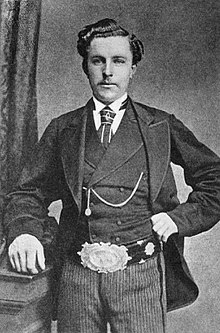
The Ring is an American boxing magazine that was first published in 1922 as a boxing and wrestling magazine. As the sporting legitimacy of professional wrestling came more into question, The Ring shifted to becoming exclusively a boxing-oriented publication. The magazine is currently owned by Oscar De La Hoya's Golden Boy Enterprises division of Golden Boy Promotions, which acquired it in 2007. Ring began publishing annual ratings of boxers in 1924. With its November/December 2022 issue, the magazine stopped publication of its regular monthly print issues and will remain a digital publication, offering occasional special interest print issues.

Mixed martial arts (MMA) is a full-contact combat sport based on striking, grappling and ground fighting, incorporating techniques from various combat sports from around the world. The first documented use of the term mixed martial arts was in a review of UFC 1 by television critic Howard Rosenberg in 1993.

PRIDE Fighting Championships was a Japanese mixed martial arts promotion company. Its inaugural event was held at the Tokyo Dome on October 11, 1997. Pride held more than sixty mixed martial arts events, broadcast to about 40 countries worldwide. PRIDE was owned by the holding company Dream Stage Entertainment (DSE).

Aloysius Martin Thesz, known by the ring name Lou Thesz, was an American professional wrestler. Considered to be one of the last true shooters in professional wrestling and described as the "quintessential athlete" and a "polished warrior who could break a man in two if pushed the wrong way", Thesz is widely regarded as one of the greatest wrestlers and wrestling world champions in history, and possibly the last globally accepted world champion.

Pancrase is a Japanese mixed martial arts (MMA) promotion company based in Tokyo. It was founded in 1993 by professional wrestlers Masakatsu Funaki and Minoru Suzuki.
Welterweight is a weight class in combat sports. Originally the term "welterweight" was used only in boxing, but other combat sports like Muay Thai, taekwondo, and mixed martial arts also use it for their own weight division system to classify the opponents. In most sports that use it, welterweight is heavier than lightweight but lighter than middleweight.

Shooto is a combat sport and mixed martial arts organization that is governed by the Shooto Association and the International Shooto Commission (ISC). Shooto was originally formed in 1985, first as a particular fighting system and then in 1989 as a mixed martial arts promotion. It is considered one of the first true mixed martial arts competitions, with its Vale Tudo Japan events being essential to the rise of Pride Fighting Championships and the development of modern MMA. Many Japanese MMA fighters had their start at Shooto and the organization still holds both professional and amateur tournaments.

A championship or title in professional wrestling is a recognition promoted by professional wrestling organizations. Championship reigns are determined by professional wrestling matches, in which competitors are involved in predetermined rivalries. These narratives create feuds between the various competitors, which cast them as villains and heroes. The bookers in a company will place the title on the most accomplished performer, or whom they believe will generate fan interest in terms of event attendance and television viewership.

Maurice L. Smith is a retired American kickboxer and mixed martial artist. In kickboxing, he held the WKC world light heavyweight championship, the WKA world heavyweight championship, and the ISKA world heavyweight championship. In mixed martial arts, he held the Heavyweight championship in Battlecade Extreme Fighting and the UFC, and became a member of the UFC Hall of Fame in 2017. A professional competitor since 1980, Smith has formerly competed in kickboxing for the companies All Japan Enterprise and K-1, Pancrase, RINGS, PRIDE, Strikeforce, International Fight League and RFA.
The super heavyweight division in mixed martial arts has no weight limit but generally refers to competitors weighing above 265 lb (120 kg). This is the definition used by the Nevada State Athletic Commission and the Association of Boxing Commissions.

Mixed martial arts weight classes are weight classes that pertain to the sport of mixed martial arts.

Travis Jon Fulton was an American mixed martial artist and a professional boxer in the heavyweight division of both sports. Known as a longtime veteran in mixed martial arts, he competed in over 300 sanctioned bouts and while he was perhaps best known for competing in smaller US-based promotions, he also competed in the UFC, the USWF, the WEC, Pancrase, M-1 Global, the Chicago Red Bears of the IFL, King of the Cage, RINGS, and Oktagon MMA. He also holds the record for the most sanctioned mixed martial arts bouts, with 320 bouts; in addition to that, he also holds the most wins in mixed martial arts history (255).
Ivan “Judo” Gene LeBell was an American judoka, stunt performer, actor, and professional wrestler. Nicknamed "The Godfather of Grappling", he popularized grappling in professional fighting circles, serving as a precursor to modern mixed martial arts. He worked on over 1,000 films and TV shows and authored 12 books.

Lee Hasdell is a British martial artist, promoter and former professional kickboxer and mixed martial artist. Hasdell is considered by many to be a pioneer of mixed martial arts in the United Kingdom, particularly in the 1990s, when he drove a great deal of innovation in the field. Hasdell promoted the first professional mixed martial arts events in the UK and helped develop many of the standards within the British MMA scene of today.

In combat sports where champions are decided by a challenge, the lineal championship in a weight class represents an intangible world title initially held by the victor of a bout between top contenders in the division, as commonly interpreted. An alternative, less mainstream perspective suggests that vacancies in divisional championships can only be filled by an undisputed champion. A fighter who defeats the reigning champion in a match within that weight class becomes the next lineal champion. In professional boxing, the informal term for the lineal champion is "the man who beat the man."
A catchweight is a term used in combat sports, such as boxing or mixed martial arts, to describe a weight limit that does not adhere to the traditional limits for weight classes. In boxing, a catchweight is negotiated prior to weigh-ins, which are conducted one day before the fight. The term may be used in professional wrestling, but should not be confused with catch wrestling, or catch division.

In boxing, a weight class is a measurement weight range for boxers. The lower limit of a weight class is equal to the upper weight limit of the class below it. The top class, with no upper limit, is called heavyweight in professional boxing and super heavyweight in amateur boxing. A boxing match is usually scheduled for a fixed weight class, and each boxer's weight must not exceed the upper limit. Although professional boxers may fight above their weight class, an amateur boxer's weight must not fall below the lower limit. A nonstandard weight limit is called a catchweight.
In professional wrestling, a weight class is a standardized weight range for the wrestlers. The top class in almost every promotion is heavyweight, but super heavyweights exist. Weight class matches in modern-day American professional wrestling are rare, but weight class championships still exist. However, Japanese professional wrestling, Mexican wrestling and traditional British wrestling use the weight classes more seriously.
Openweight, also known as Absolute, is an unofficial weight class in combat sports and professional wrestling. It refers to bouts where there is no weight limit and fighters with a dramatic difference in size can compete against each other. It is different from catch weight, where competitors agree to weigh in at a certain amount without an official weight class. While weight classes are usually mandatory now, openweight competition was the norm for combat sports since antiquity and continues into the modern day.
















